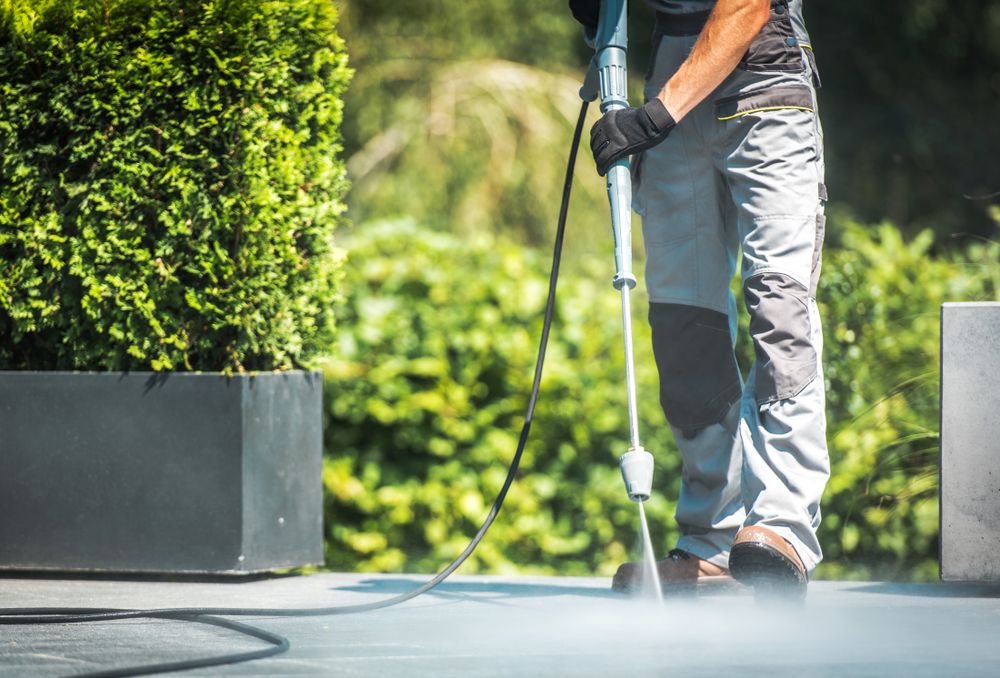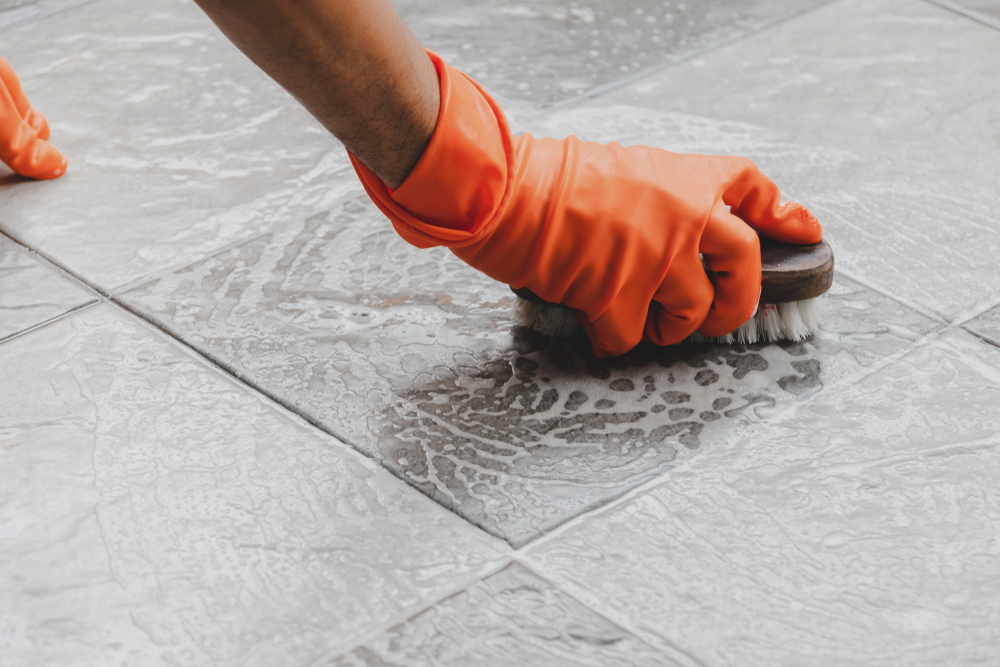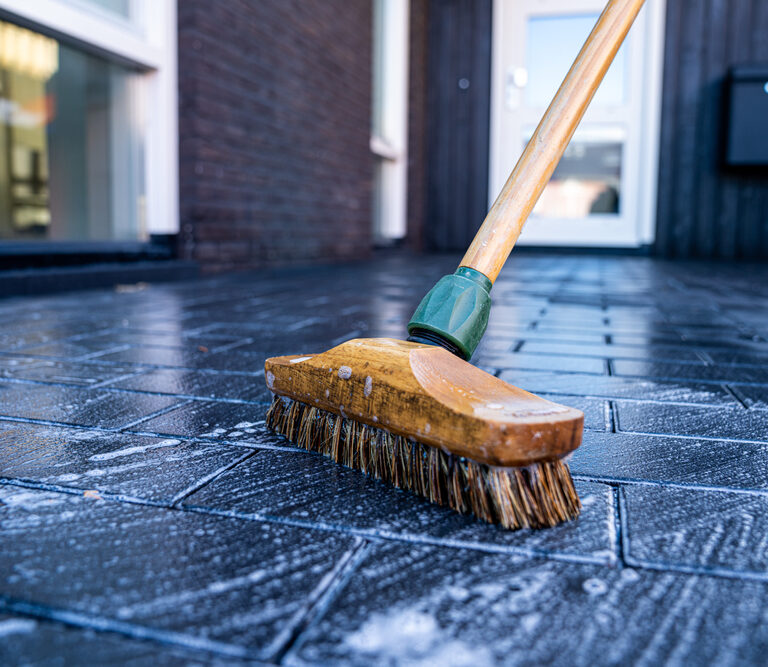It takes a lot to get concrete dirty, but over the years, the concrete floors in your home – both inside and out – may start to appear as if they have seen better days. Mold, mildew, grease stains, and oil stains can all contribute to an overall dirty appearance of your concrete.
If you want to clean the concrete areas in your home, be prepared to do some scrubbing! There are several methods that will help you efficiently clean the concrete, but you should be ready to put in the elbow grease to make it work. In this article, we will discuss how to clean concrete and give you advice for the different types of cleaning methods and the materials needed.
Important Advice for Concrete Cleaning
Before you get to work collecting your cleaning materials and scrubbing at your concrete, there are a few words of wisdom you should follow.
Pre-Clean the Area
Any concrete area that you are trying to clean should be free from dirt, debris, dust, and, in the case of outdoor concrete, furniture. You need to completely expose the concrete surface for effective cleaning and should be removing everything that may stop you from evenly treating the area.
Additionally, if you have plants or a garden directly next to the concrete areas you are cleaning, you should be covering them up completely (the same way you would cover them to protect from frost). Run-off from chemicals or other cleaning materials into your flower beds can ruin the plants and cause them to wilt.
Know Your Stain
Different types of concrete stains and dirt have slightly different treatment methods. Below, we discuss how to clean some of the most common stains off; evaluate the stains and dirt on your concrete and then choose the method that will be the most effective in your situation.
Consider Pressure Washing
If the concrete you are trying to clean is outdoors, you may want to consider investing in a pressure washer. These machines use high-powered water and cleaning solution mixed together to blast dirt off of your concrete.
Keep in mind that proper safety precautions need to be taken when using a pressure washer, and that pressure washing may not be able to remove stubborn stains like grease and oil. They are, however, perfect for general dirt and mildew cleaning.
Materials You Will Need to Clean Concrete
Depending on how dirty your concrete is and what types of stains you are dealing with, you made need to use a variety of cleaning materials. The basic cleaning products needed are a broom, a bristled brush for scrubbing, a large bucket filled with hot water, dish soap, and baking soda.
Alternate methods may include oxygenated bleach (a safer alternative to regular chlorine bleach), cornstarch or kitty litter, and vinegar.
It is perfectly acceptable to use multiple methods to completely clean your concrete, but make sure to thoroughly rinse off all cleaning materials and let the area dry before trying a different method. This is done to prevent chemicals mixing and creating problems with fumes or adverse chemical reactions.

Steps for Cleaning Concrete Surfaces
These steps can be used on any type of concrete surface, indoor or outdoor. Make sure that the area you are cleaning is well-ventilated and that you are careful not to splash cleaning materials in other areas of your home or into your plants.
Most concrete areas can be cleaned with the basic dirty concrete set of steps, but if you have tougher stains or more specialized concrete cleaning needs, you can opt to use one of these other methods. Alternatively, you can give your concrete a once over with the basic steps and then spot clean areas with the other methods as needed.
Cleaning Dirty Concrete
For this method, make sure the concrete surface you are working on it swept clean and free of any type of debris. Fill your bucket with a gallon of hot water, add a half a cup of baking soda and a few tablespoons of liquid dish soap, and then mix it together thoroughly.
Use your broom to wet the entire surface with this mixture, concentrating on spots that are visibly dirty. You can use your scrubbing brush to work the mixture into these areas harder and break down larger areas of dirt.
While the concrete is still wet, sprinkle oxygenated bleach, such as OxiClean, across heavily stained areas. Once you have put down a light coating, use your broom or a scrubbing brush to work the bleach into the area.
Wait 10 to 15 minutes and then rinse down all of the concrete with clean water. Make sure to also rinse your bucket, broom, and scrubbing brush.
As soon as the concrete is dry, you can evaluate whether you need to apply a different cleaning method or simply repeat these steps once more time to achieve maximum concrete cleanliness.
Removing Mold and Mildew From Concrete
If you notice that you have mold or mildew stains lingering after your initial cleaning process, you can spot treat these areas with vinegar and hot water. Mix the two in equal parts and then apply it to the area in question. Scrub it in before rinsing the surface and letting air dry.
If the stains are still there after the vinegar treatment, you can follow up this process by adding a quarter of a cup of oxygenated bleach into a gallon of hot water and applying this to the area. Let it sit for at least 15 minutes before rinsing the surface with clean water and then letting it dry.
Removing Grease and Oil From Concrete
Grease and oil stains are exceedingly stubborn to remove from any surface, including concrete. It will likely take you two to three repetitions of this cleaning process to fully remove any trace of grease or oil on your concrete.
Wherever you see a grease or oil stain, take cornstarch (or kitty litter, depending on what you have on hand) and cover the stain in a thick layer. Don’t be afraid to coat the area liberally, as these substances will be able to pull the grease or oil out of the concrete when applied in a large amount.
Allow the cornstarch to sit overnight and sweep it up in the morning. You should now combine a quart of hot water and a teaspoon of liquid dish soap in your bucket, and then apply it to the area of concrete you are trying to clean.
Scrub in this mixture with your broom or scrubbing brush and then rinse the area with clean water. Once the concrete air dries, you can evaluate whether you need to repeat the process to fully remove the stain.
Removing Rust Stains From Concrete
Rust stains can also be very stubborn to remove. If you manage to catch the rust stain early enough, you should be able to scrub it out using a rag or a scrubbing brush and straight, undiluted vinegar. Apply the vinegar to the stain and then scrub until it is gone, making sure to thoroughly rinse the vinegar off afterwards.
For very stubborn or older rust stains, you can sprinkle a cleaner that features oxalic acid over the area, as this type of cleaner can easily dissolve rust stains. Simply sprinkle it over the affected area and scrub it in before rinsing the area. You may need to repeat this once or twice to completely clean the rust from your concrete.

How Often Should You Clean Concrete?
How often you clean your concrete is really dependent on how dirty your concrete gets and what you are using the concrete for. If the only concrete area in your house is your garage, you’re probably ok with only cleaning it once a year to remove grease and oil stain buildups.
If you have a concrete patio that you use year-round, you may want to up your cleaning frequency to two or three times a year in order to keep the concrete looking nice for both you and any guests you may host on the patio.
Protecting Your Concrete
Once your concrete is cleaned, there are some steps you can take to prevent it from getting too dirty in the future.
Seal Floors
Applying a sealant to the concrete floors in your home is a great way to prevent dirt buildup from occurring. These sealants will protect the condition of your concrete and stop stains from ever forming, meaning that you won’t have to constantly reclean the concrete to keep it looking nice.
You can apply a sealant yourself, or you can hire a professional to do it.
Use Drip Mats
If you frequently work on your car in your garage or driveway, make sure to use drip mats to catch any oil or gasoline leakages. You can also place drip mats below where you usually park your car or below an outdoor grill to prevent grease stains from occurring.
Use Outdoor Rugs
On a concrete patio, an outdoor rug can be perfect for stopping rust and catching spills. You can put out the rug during your location’s warm seasons, placing it underneath any patio furniture. Make sure to sweep the rug each week and remove it during the winter and in long periods of rain, as this will prevent mildew from forming on it.
Spring Clean Your Concrete
While they are resistant to many things, the concrete surfaces in and around your home are not completely resistant to becoming dirty or picking up stains over the course of their life. In order to keep the concrete looking fresh and clean, be sure to wash it on a routine basis. This will prevent a buildup of dirt and stains and leave you with the cleanest possible concrete year-round.
